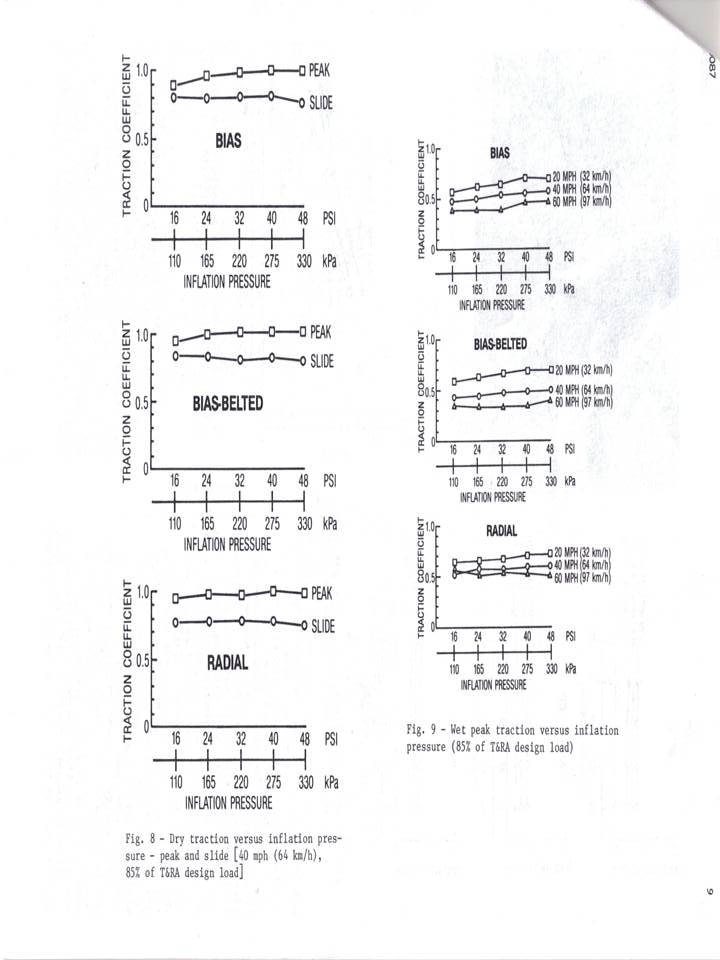Except in aquaplaning where higher inflation reduces it.
Something I suspected but didn't have the info to back it up.
AutoSpeed - Tyres, Grip and All That.
Quote:
Myth 2: A larger contact patch = more grip
Okay, most people will come to the conclusion that if you have "more rubber on the road" you will have increased grip. Sorry to say this folks, but to very close to 100% accuracy, the size of the contact patch is irrelevant.
The actual grip that a tyre can generate is dictated by the coefficient of friction of the rubber compound used in the tyre.
|
Quote:
|
One issue to consider is that, for wet weather driving, despite what you may have heard, it is better to increase your tyre pressure, not reduce it. The reason is that there is a relationship between tyre pressure and the speed at which there is the onset of aquaplaning. In the Imperial system, the equation is 9 times the square root of the tyre pressure. So, if your tyres are at 25 psi, if you drive into a puddle that is deeper than your tread depth, you will aquaplane at 45 mph (72 km/h), whereas if your tyre pressure was 36psi, you would aquaplane at 54 mph (87 km/h). The advantages are obvious.
|
Quote:
|
The tyre pressure has no direct bearing on the level of grip (apart from aquaplaning), but it does have a bearing on the heating and cooling characteristics of the tyre.
|
ADDED: I'm putting all my links here for easy access:
According to these tests Higher inflation pressure reduced stopping distance and increased coefficient of friction...Scroll down for stopping distances.
FEA chapter III. tire pressure survey and test results
From NHTSA
Passenger van tire inflation study.
Quote:
Analysis:
Good tire care improves vehicle
handling as well as fuel efficiency
and tire life. Proper tire maintenance
can prevent such events as tread
separations and tire blowouts which
may cause loss of control of a vehicle,
when not handled properly, and result
in a rollover. Low tire pressure can
also increase stopping distances and
the chance of hydroplaning on wet
surfaces.
|
http://www.maic.qld.gov.au/forms-pub...port-final.pdf
Found some interesting pages from a racing tire book. I have not had time to read the whole thing.
From excerpt#1
Quote:
|
Adhesion is a property of rubber that causes it to stick to other materials, as we see with adhesive tape. Adhesion is generally thought to be the result of momentary molecular bonding between the two surfaces. If bond strength is the same at all the bond sites the force that resists sliding is proportional to the total of all the minute areas of contact. If the two surfaces were perfectly smooth the true area of contact would be the same as the observed area of contact, but this is not the case. Real surfaces are actually very rough on the molecular scale and contact is limited to the highest protuberances on each of the two surfaces. The true area of contact depends on the surface profiles, properties of the materials, and the contact pressure.
|
 Tire Technology, excerpt from The Racing & High-Performance Tire
Tire Technology, excerpt from The Racing & High-Performance Tire
From excerpt #2
Quote:
|
At higher slip angles portions of the tire patch are sliding, and you get less increase in lateral force with an increase of slip angle. This is called the transition region. As the curve tops out, more of the contact patch is sliding and the tire produces less lateral force. After the peak of the curve, lateral force can fall off 30% within a few degrees of extra slip angle. At these high slip angles most of the contact patch is sliding, producing a lot of heat and wear.
|
 Tire Technology, excerpt no. 2 from The Racing & High-Performance Tire
Tire Technology, excerpt no. 3 from The Racing & High-Performance Tire
Tire Technology, excerpt no. 2 from The Racing & High-Performance Tire
Tire Technology, excerpt no. 3 from The Racing & High-Performance Tire
SAE paper digested for us by Barry.
Barry's Tire Tech
Peak traction goes up and sliding down a tiny bit. ABS would like this. Also they found cornering response and cornering traction improves. The only downside was bruise resistance and puncture blow out got worse with higher pressure (not surprising.)

This is not advice. I'm just sharing waht I have found.
My personal opinion is that tire inflation to max sidewall is generally better for the following reasons:
1) Lower heat build up. Reduced risk of accident or rollover resulting from loss of control from heat related tire failure.
2) Reduced wear
3) Slightly increased peak traction, slightly reduced sliding traction. Slightly reduced stopping distances (
may have to do with increased traction)
4) Reduction in hydroplaning (onset of hydroplaning happens at a higher speed)
5) Reduces slipping in snow* (depending on conditions, sometimes lower pressure is better)
6) Increases tire responsiveness in cornering.
7) Reduces body lean in cornering, improves steering feedback (subjective)
8) Reduces fuel consumption
9) Reduces steering effort
Downsides to max sidewall:
1) Slightly harsher ride quality.
2) May increase rollover tendency in already rollover prone SUVs
3) Harder on suspension components in rough road conditions
4) Increases risk of tire bruising or failure from impact with certain objects.